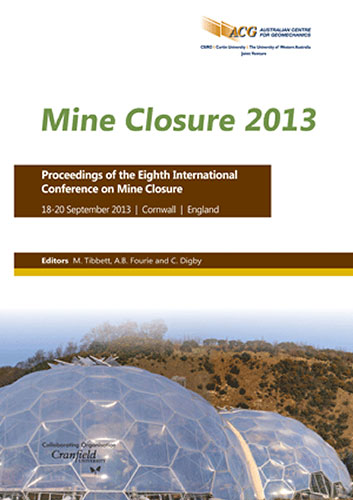Fifteen years of design, construction and monitoring of soil covers on Wismut´s uranium mining legacy sites – a synopsis

|
Authors: Barnekow, U; Paul, M |
DOI https://doi.org/10.36487/ACG_rep/1352_10_Barnekow
Cite As:
Barnekow, U & Paul, M 2013, 'Fifteen years of design, construction and monitoring of soil covers on Wismut´s uranium mining legacy sites – a synopsis', in M Tibbett, AB Fourie & C Digby (eds), Mine Closure 2013: Proceedings of the Eighth International Seminar on Mine Closure, Australian Centre for Geomechanics, Cornwall, pp. 109-122, https://doi.org/10.36487/ACG_rep/1352_10_Barnekow
Abstract:
In East Germany, uranium mining and milling by the Soviet-German Wismut company took place from 1946 to 1990 and involved production of 216,000 t of uranium. In 1990, the legacy sites enclosed five underground mines, contaminated operational areas (37 km²), 60+ waste rock dumps (325 million m³), an open pit (1.6 km²) and six large mill tailings ponds (5.7 km², 160 million m³). In 1991 the German federal government committed €6.6 billion to the remediation of the sites and founded Wismut GmbH to take responsibility for decommissioning and remediation. In 2012, Wismut met its responsibilities to carry out works with a budget of € 144 million. The materials to be covered are usually classified as radioactive matter and are susceptible to acid rock drainage. The underground mine workings, waste rock dumps and tailings ponds are sources of radiation exposure and contaminated seepage. According to German mining law, decommissioning of uranium mining and milling sites is required to eliminate acute risks and reduce the environmental impact. With regard to radiation protection of the local public, the effective dose must be reduced to below 1 mSv/year after decommissioning. This paper presents a synopsis of at least 15 years of design, construction and monitoring experience with soil covers on Wismut’s uranium mining legacy sites. Soil cover types have been designed to address the following remediation objectives: prevent direct access to radioactive matter by the public, prevent external radiation (direct radiation and dusting), limit radon exhalation, limit oxygen intrusion, provide a stable plant-available water supply for vegetation, control or minimise net percolation through the cover and vegetate. Since the 1990s, Wismut has placed soil covers on numerous waste rock dumps, mill tailings ponds and the backfilled Lichtenberg open pit as well as contaminated sites. Soil-hydrological monitoring stations have been installed to measure the day-to-day water balance. These stations were usually equipped with lysimeters and sensors to continuously measure unsaturated water flow, soil suction and water content in the cover system. The climate at Wismut varies due to topography and can be characterised as moderately humid with average temperatures of ca. 8.5°C and a central European winter and summer season. Cover types include (a) two-layer covers designed particularly with respect to radon exhalation; (b) single-layer and two-layer covers designed according to store-and-release principles as well as with respect to radon exhalation and oxygen intrusion; and (c) multilayer-type covers currently planned for the future to be built on partial areas of Culmitzsch tailings pond. The paper concludes with the outlook for long-term stewardship.
References:
O’Kane, M., Roscher, M. and Barnekow, U. (2011) Hydrology of soil covers on mine wastes – selected examples of Wismut and international experiences, Nachhaltigkeit und Langzeitaspekte bei der Sanierung von Uranbergbau- und Aufbereitungsstandorten, in Proceedings des Internationalen Bergbausymposiums WISSYM2011, 25–27 May 2011, Wismut GmbH, Ronneburg, Germany, pp. 167–185.
Merkel, G. and Lindner, S. (2013) Design, construction and monitoring of the final cover on Wismut’s Truenzig tailings pond, in Proceedings Eighth International Conference on Mine Closure (Mine Closure 2013), M. Tibbett, A.B. Fourie and C. Digby (eds), 18‒20 September 2013, Cornwall, United Kingdom, Australian Centre for Geomechanics, Perth.
Regner, J. and Schulz, H. (2008) Development of an object-specific remediation solution, for the waste rock dumps at the formerly abandoned Wismut sites, KERNTECHNIK, Vol. 73(3), pp. 1–5.
Schramm, A. and Roscher, M. (2013) Two-layer soil covers on selected radioactive waste rock dumps at Wismut – results of more than 10 years of hydrological monitoring, in Proceedings Eighth International Conference on Mine Closure (Mine Closure 2013), M. Tibbett, A.B. Fourie and C. Digby (eds), 18‒20 September 2013, Cornwall, United Kingdom, Australian Centre for Geomechanics, Perth.
© Copyright 2025, Australian Centre for Geomechanics (ACG), The University of Western Australia. All rights reserved.
View copyright/legal information
Please direct any queries or error reports to repository-acg@uwa.edu.au
View copyright/legal information
Please direct any queries or error reports to repository-acg@uwa.edu.au